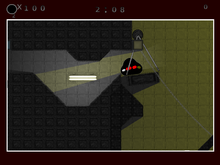Chronic Logic
| Chronic Logic | |
|---|---|
| legal form | Limited Liability Company |
| founding | 2001 |
| Seat |
Santa Cruz (California) , United States |
| Branch | Software development |
| Website | chroniclogic.com |
Chronic Logic is an independent computer game developer group . It was founded in 2001 by Alex Austin and Ben Nichols after the huge success of Austin's bridge building simulation Bridge Builder promised that there was interest in such small games. The successors to Bridge Builder , especially Pontifex and Bridge Construction Set , are Chronic Logic's most successful releases.
history
The first game published by Chronic Logic was Pontifex, the successor to Bridge Builder .
In February 2002, Chronic Logic moved into a new office. Josiah Pisciotta joined the developers.
In the same year, they stopped developing a larger title to develop a small computer skill game. According to their own information, a publication was not planned from the outset, but ultimately the game was published under the name Triptych .
In September 2002 the third game, Pontifex II , was released. The title was later changed to Bridge Construction Set . It won the Independent Games Festival Audience Award in 2003.
In January 2003 Austin and Pisciotta acquired Ben Nichol's stake in Chronic Logic. Ben Nichol had left the group a few months earlier.
Other games published by Chronic Logic include Bridge It , a fourth bridge building simulation created in collaboration with Nvidia and Auran , and Gish , which was featured in The New York Times .
Games
Triptych
Triptych ( English for triptych ) is a Tetris -like computer game . The player controls elastic stones that obey the laws of physics. If at least three sub-blocks of the same color touch, they dissolve.
Gameplay
As with Tetris , you have a rectangular playing field into which stones fall one after the other. However, the control of the stones is expanded: the stones can be moved steplessly. The control options are left, right, up, down and turns clockwise or counterclockwise , while gravity always acts on the stone. In addition, the stones behave elastically on impact and can then be moved further. In contrast to Tetris, the stones only consist of three parts, which results in two possible shapes.
The control of the respective block is limited in time. If the time has expired, which is symbolized by a green column next to the playing field, the block falls uncontrollably, but according to the laws of physics to the ground and a new block appears that can be controlled. The player can also give the block out of control prematurely so that he has more time for the next block.
The sub-blocks usually have different colors. Unlike Tetris, it's not about filling a row. When three parts of the same color touch, they become “electrified” and disappear.
The upper edge of the field is a restricted area. If after the time limit for the controlled block there is still any non-electrified part in it, the game ends.
The score for an electrified block increases for a limited time (right green column) when more parts are electrified. Other electrified parts further increase the score and give additional time.
Match practice
In order not only to survive long, but also to collect a lot of points, the bonus must be driven as high as possible. This makes the game much more hectic than with Tetris, even at lower levels , which only rewards the quick dropping of blocks with insignificant points.
Pontifex, Pontifex II / Bridge Construction Set, Bridge It
see Bridge Builder
Gish
This is an unusual jump 'n run. The player controls a lump of tar that behaves according to the laws of physics. A special feature is that there is no special button for most actions, but that the way in which you get the desired result results from physics; For example, if you want to throw a box over an abyss, you cannot simply press "take" and "throw" it. Instead, you make the surface of the tar lump sticky, touch the crate, roll away from the crate a bit which causes the crate to be pulled onto the tar lump, then let the crate sink in a little, and finally let the tar lump form into a ball freeze, which then causes the box to be pushed away. In 2010 Gish was part of the very successful first Humble Indie Bundle and because of the success, the source code of the game was released under an open source license. As a result, Gish was ported to other platforms by enthusiasts such as: B. AmigaOS 4, Linux , Mac OS X and the handheld console Pandora .
Web links
Individual evidence
- ^ Gish Open Source
- ↑ GISH for AmigaOS 4
- ↑ Freegish on github . Retrieved April 7, 2014.
- ↑ http://opengameart.org/forumtopic/freegish
